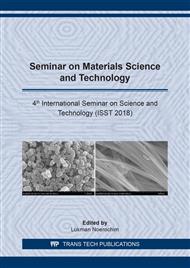[1]
J.M.O. Scurlock, D.C. Dayton, B. Hames, Bamboo: an overlooked biomass resource?, Biomass and Bioenergy. 19 (2000) 229-244.
DOI: 10.1016/s0961-9534(00)00038-6
Google Scholar
[2]
M.-F. Li, Y.-M. Fan, F. Xu, R.-C. Sun, X.-L. Zhang, Cold sodium hydroxide/urea based pretreatment of bamboo for bioethanol production: Characterization of the cellulose rich fraction, Industrial Crops and Products. 32 (2010) 551–559.
DOI: 10.1016/j.indcrop.2010.07.004
Google Scholar
[3]
H. Ardhyananta, F. Abdul, Widyastuti, Sulistijono, A. Hassan, D. Kurniawan, Tensile and Thermal Properties of Bambusa arundinacea and Dendrocalamus asper Culm Fibers, Advanced Materials Research. 845 (2014) 237-240.
DOI: 10.4028/www.scientific.net/amr.845.237
Google Scholar
[4]
E.L.K. Mui, W.H. Cheung, M. Valix, G. McKay, Activated carbons from bamboo scaffolding using acid activation, Separation and Purification Technology. 74 (2010) 213–218.
DOI: 10.1016/j.seppur.2010.06.007
Google Scholar
[5]
D. An, Y. Guo, B. Zou, Y. Zhu, Z. Wang, A study on the consecutive preparation of silica powders and active carbon from rice husk ash, Biomass and Bioenergy. 35 (2011) 1227-1234.
DOI: 10.1016/j.biombioe.2010.12.014
Google Scholar
[6]
Q.-S. Liu, T. Zheng, P. Wang, L. Guo, Preparation and characterization of activated carbon from bamboo by microwave-induced phosphoric acid activation, Industrial Crops and Products. 31 (2010) 233–238.
DOI: 10.1016/j.indcrop.2009.10.011
Google Scholar
[7]
J.J. Pis, M. Mahamud, J.A. Pajares, J.B. Parra, R.C. Bansal, Preparation of active carbons from coal Part III: Activation of char, Fuel Processing Technology. 57 (1998) 149–161.
DOI: 10.1016/s0378-3820(98)00083-6
Google Scholar
[8]
M. Kubota, A. Hat, H. Matsuda, Preparation of activated carbon from phenolic resin by KOH chemical activation under microwave heating, CARBON. 47 (2009) 2805–2811.
DOI: 10.1016/j.carbon.2009.06.024
Google Scholar
[9]
L. Wang, X. Wang, B. Zou, X. Ma, Y. Qu, C. Rong, Y. Li, Y. Su, Z. Wang, Preparation of carbon black from rice husk by hydrolysis, carbonization and pyrolysis, Bioresource Technology. 102 (2011) 8220–8224.
DOI: 10.1016/j.biortech.2011.05.079
Google Scholar
[10]
A.A. Ahmad, B.H. Hameed, Effect of preparation conditions of activated carbon from bamboo waste for real textile wastewater, Journal of Hazardous Materials. 173 (2010) 487–493.
DOI: 10.1016/j.jhazmat.2009.08.111
Google Scholar
[11]
M. Valix, W.H. Cheung, G. McKay, Preparation of activated carbon using low temperature carbonisation and physical activation of high ash raw bagasse for acid dye adsorption, Chemosphere. 56 (2004) 493–501.
DOI: 10.1016/j.chemosphere.2004.04.004
Google Scholar
[12]
J. Zhu, J. Jia, F.L. Kwong, D.H.L. Ng, S.C. Tjong, Synthesis of multiwalled carbon nanotubes from bamboo charcoal and the roles of minerals on their growth, Biomass and Bioenergy. 36 (2012) 12-19.
DOI: 10.1016/j.biombioe.2011.08.023
Google Scholar
[13]
G. Sun, X. Li, H. Yan, J. Qiu, Y. Zhang, Production of nanosized graphite powders from natural graphite by detonation, CARBON. 46 (2008) 476–481.
DOI: 10.1016/j.carbon.2007.12.013
Google Scholar
[14]
L. Zhu, F. Shen, R. L. Smith Jr, L. Yan, L. Li, X. Qi, Black liquor-derived porous carbons from rice straw for high-performance supercapacitors, Chemical Engineering Journal. 316 (2017) 770–777.
DOI: 10.1016/j.cej.2017.02.034
Google Scholar
[15]
A. B. Fuertes, M. Sevilla, High-surface area carbons from renewable sources with a bimodal micro-mesoporosity for highperformance ionic liquid-based supercapacitors, CARBON. 94 (2015) 41-52.
DOI: 10.1016/j.carbon.2015.06.028
Google Scholar


